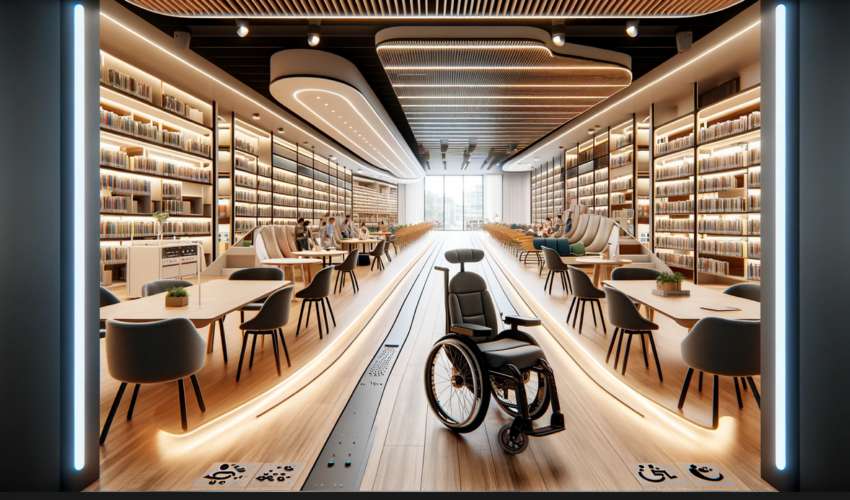Adaptive Design: Crafting Spaces for Differently-Abled Individuals

A Wildly Inclusive Ride Through Interior Design
Picture this, my dear readers: you're throwing a housewarming party, and you've invited a diverse range of friends, family, and acquaintances. As you watch your guests interact, you start to notice that some are struggling to navigate your home. Your friend who uses a wheelchair can't access the kitchen because of a narrow doorway. Another friend with a visual impairment seems perpetually confused by the dim lighting. Meanwhile, your cousin with a prosthetic leg is avoiding the stairs like the plague.Embarrassment consumes you, and you vow to do better. But how?
Enter the world of adaptive design, my friends. A magical realm where every space is usable, practical, and enjoyable for people of all abilities. It's not just about ramps and handrails, it's about crafting environments that cater to the needs of differently-abled individuals and enhancing their quality of life. So if you're ready to embark on an educational journey into the inclusive world of adaptive design, buckle up and keep reading.
The Principles of Adaptive Design
Before we begin our wild ride through the galaxy of adaptive design, let's lay down some ground rules. Adaptive design is centered around a few key principles:- Accessibility: The space must be easy to navigate and use for people with a wide range of abilities.
- Flexibility: The space must be adaptable and versatile, allowing individuals to use it in different ways.
- Usability: The space must be designed with ease of use in mind, minimizing frustration and confusion.
- Comfort: The space must be comfortable and inviting, encouraging individuals to stay and engage with their surroundings.
- Aesthetics: Just because it's functional doesn't mean it can't be beautiful. The space should be visually appealing and thoughtfully designed.
Doorways, Hallways, and Stairways, Oh My!
Let's start with the basics: getting from point A to point B. For many differently-abled individuals, navigating a space can be a significant challenge. Thankfully, there are some easy steps you can take to smooth the way:- Widen doorways and hallways to at least 36 inches, allowing for wheelchair users and those using mobility aids to move freely.
- Install ramps or lifts to help individuals with mobility impairments navigate stairs or steps.
- Consider slip-resistant flooring materials to minimize the risk of falls and injuries.
- Ensure that handrails and grab bars are sturdy and well-placed, providing support and stability where needed.
Let There Be Light!
Lighting is one of the most overlooked aspects of adaptive design. Yet, as our visual impairment example earlier demonstrated, inadequate lighting can be a significant barrier for some individuals. Here's how to let the light shine:- Choose bright, evenly distributed lighting to minimize shadows and dark areas.
- Consider installing adjustable lighting controls, allowing individuals to customize the lighting to their preference.
- For those with vision impairments, use contrasting colors and textures to help distinguish different surfaces and areas.
Function Over Form
When it comes to furniture and home accessories, it's time to prioritize function over form. Here are some tips for selecting adaptable and inclusive pieces:- Choose adjustable furniture, such as height-adjustable tables or chairs with adjustable armrests, to accommodate a range of needs.
- Opt for furniture with easy-to-grip handles and knobs, making them usable for individuals with limited dexterity.
- Consider furniture layouts that allow for ample space to move and navigate, avoiding clutter or tight arrangements.
Everyday Tasks Made Easy
Last but not least, let's consider how adaptive design can make everyday tasks more manageable for differently-abled individuals:- Install easy-to-use faucets with lever handles or touchless controls in kitchens and bathrooms.
- Mount electrical outlets and light switches at accessible heights, allowing individuals to reach them without strain or difficulty.
- Opt for appliances with large, easy-to-read controls and tactile feedback.
- Choose countertops and work surfaces at varying heights, allowing individuals to work comfortably while sitting or standing.
Article kindly provided by designerviews.org
Latest Articles
- Crafting Interiors That Help Music Truly Come Alive
- Why Packaging Design Matters Even for Digital Products
- Color Palettes That Evolve: Creating Schemes That Shift With Time of Day, Mood, or User Context
- Exploring Subtle Details Found in Quality Swiss Timepieces
- How Adaptive Cabin Environments Let Chauffeured Executives Shift Effortlessly Between Rest and Focus
- Jewellery as Identity Encryption: Choosing Symbols That Speak Only to You
- From Minimal to Maximal: Print Styles That Actually Fit Your Decor
- From Cathedrals to Conference Halls: How Venue Acoustics Change the Meaning of Music
- How to Photograph Big Celebrations Without Interrupting the Flow
- Selecting an SEO Company When Your Business is Design-Driven: What Creative Agencies Should Know
- Unexpected Light Sources That Make Photographers Look Clever
- Understanding the Emotional Grammar of Portrait Light
- Why the Humble Photo Booth is the Secret Glue of a Wedding Day
- Hues That Hug: Creating Calm, Focus, and Joy Through Sensory Colour
- How Monochrome Shifts Perception in Wildlife and Landscape Imagery
- Color Grading Secrets That Make It Look Like You Had a Lighting Crew
- Photography: Blending Environmental Portraiture Into Ordinary Home Spaces
- Charity Comm's Greatest Hits and How to Actually Fix Them
- Pop-Up Studio on the Move Makes Mobile Portrait Setups Work Anywhere
- Time Proof Your Visual Stories With Techniques That Outlive Trends
- Architecture
- Graphic Design
- Web Design
- Industrial Design
- Interior Design
- Fashion Design
- Photography
- Product Design
- UI/UX Design
- Landscape Design
- Animation
- Industrial Engineering
- Packaging Design
- Branding and Identity Design
- Exhibit Design
- Advertising Design
- Typography
- Motion Graphics
- Sustainable Design
- User Research
- Fashion Merchandising
- Film and Video Production
- UX Writing
- Environmental Design
- Print Design
- Interaction Design
- Art Direction
- Textile Design
- Game Design
- Virtual Reality (VR) Design
- General Design Principles
- Event and Wedding Design

